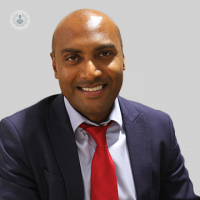Breast reconstruction after a lumpectomy
Written by:The purpose of a breast lumpectomy is to remove breast tissue to clear a patient of breast cancer. Another name for it is a wide local excision. It is best for smaller breast cancers. The cancer can be safely removed with a margin of normal breast tissue, without causing damage to the remainder of the breast. Mr Seni Myvaganam tells us more about breast reconstruction, following a lumpectomy.

The advantage is that patients can retain their own breast tissue and there is often no need for any reconstruction. It is important to note that when a patient has a lumpectomy to remove breast cancer, radiotherapy is always recommended after. Radiotherapy sterilises the remainder of the breast tissue and makes the risk of recurrent breast cancer as low as if the patient had had a mastectomy. A mastectomy removes all of the breast tissue to clear a patient of breast cancer.
Another advantage of a lumpectomy is that it may facilitate smaller scars, so, cosmetically it can be a lot better for the patient and their psychological well-being after having undergone breast cancer surgery.
How is the breast reconstructed after having a lumpectomy?
The aims of successful breast-conserving surgery for cancer is to first and foremost remove the breast cancer completely and then ensure there is minimal damage to the breast. Plastic surgery techniques can be used when the cancer is removed to ensure not to leave a defect in the remaining breast that can affect the final cosmetic result. In addition, they can ensure a cosmetically satisfactory breast shape is achieved.
A lumpectomy is generally done for smaller breast cancers, but plastic techniques can be used to remove larger breast cancers with the remainder of the breast reshaped to hide any defect. Surgery for larger cancers may require larger scars and will result in a smaller breast after the procedure as less breast tissue remains after the removal of large cancer. In addition, it usually changes the shape of the breast to a more ‘pert’ uplifted shape.
Will I need a breast implant after a lumpectomy?
On occasion, patients may wish to replace the volume lost following the removal of cancer if the patient wishes to remain the same cup size as before. To do this the patient might decide on an implant or use their own tissue and transfer this from elsewhere into the breast. The most appropriate strategy here will differ depending on the cosmetic needs of the patient.
Most patients do not opt for replacement of breast volume after a lumpectomy but choose for breast reshaping as described. If larger breast volumes are removed due to the size of the cancer then the degree of volume change and ‘pert’ breast shape recreated can produce noticeable asymmetry to the opposite breast. Mr Mylvaganam recommends here that patients have a breast reduction or uplift to the other breast, following a lumpectomy to achieve breasts of equal size and symmetry.
Will I need nipple reconstruction?
Whether the nipple is removed or not as part of a mastectomy, in part depends on the cancer that we are dealing with. If the nipple is removed, there is the option of nipple reconstruction, as well as tattooing of the nipple and areola at a later date.
Those options are always offered to ladies but it is the lady's choice whether they wish to have that done or not. Nipple reconstruction will involve a small operation which can be done under local anaesthetic and tattooing can be done as an outpatient procedure. Nipple reconstruction and tattooing can make a significant difference to the patient impression of the final cosmetic appearance of the breast and also to satisfaction.
If you have undergone breast cancer surgery and would like to know more about breast reconstruction following your operation, please visit Mr Mylvaganam’s profile.


